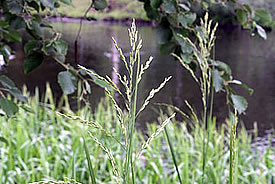
Reed meadow grass (Photo by Matti Virtala, Wikimedia Commons)
Reed meadow grass
Reed meadow grass is a wetland grass that was introduced in the 1940s as a forage plant that could be planted in wet pasture areas for cattle in North America. It subsequently spread throughout Ontario, where it is has overtaken native cattails and other species.
How is it identified?
This grass has an open, many-branched stem with yellow-green or purple-tinged flowers that bloom from June to August. The leaves are typically one to two centimetres wide and up to 45 centimetres long with prominent mid-ribs. The leaf edges are rough with short stiff hairs.
Where does it grow?
Reed meadow grass can be found in wetlands and along the edges of streams, rivers and lakes. This plant is usually found in wet, nutrient-rich wetlands and seasonally flooded areas in Alberta and Ontario.
What does it threaten?
Despite being introduced as forage for livestock, reed meadow grass is unsuitable to most animals because the young shoots contain cyanide. It outcompetes native plants and reduces seed availability for birds.
How can you help?
Reed meadow grass looks very similar to many other grasses. In Ontario, contact Ontario's Invading Species Awareness Program for identification help and control suggestions.
Everyone can help to win the battle against alien invasive species. Here are some ways you can help:
- Dispose of yard waste properly. Dumping yard waste in natural areas can introduce alien invasive species that will thrive and spread. Even leaf piles can be problematic, as dumped piles can smother native vegetation. Contact your municipality to find out how to dispose of yard waste properly.
- Plant native species in your garden. There are lots of beautiful native species that attract native butterflies and birds, making your garden twice as beautiful. Native species are also adapted to our climate and often require less rigorous care than exotic species.
- Report sightings of invasive plants to your local stewardship council. Finding these invasions early is key to eradicating them.
- Clean your shoes or bicycle tires when moving between designated trails in different areas. Invasive plants are often spread accidentally from seeds stuck in treads.





